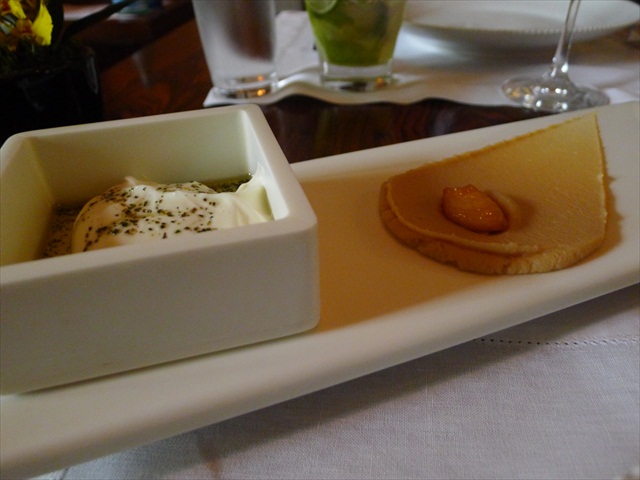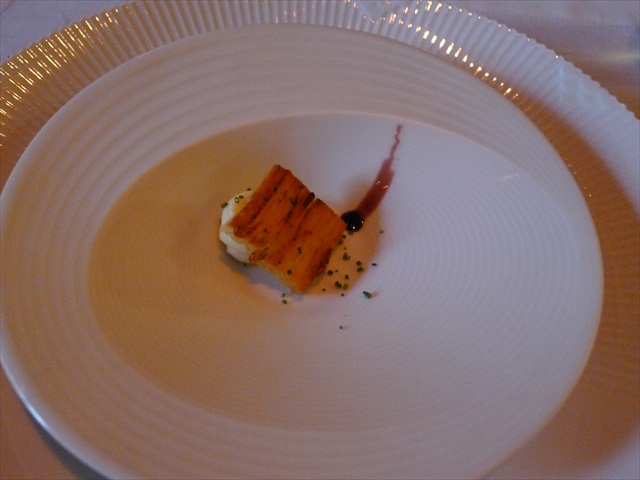It was the last of the great meals. A destination in itself. After expending hard-to-justify amounts of time, cash, kilometres and kilograms in a vain quest to sample the best, we arrived in Sao Paulo.
Our destination? D.O.M; currently ranked as the fourth best restaurant in the world.
Over the last few years we’ve had something of a mad mission to try and make it to the rest of the top ten. Hedonism and a quest to inject a bit of wonder into our days before domesticity takes over have been at its root.
And so, on a steamy afternoon in January, we flew from Rio to Sao Paulo- leaving ourselves a mere afternoon to explore, an evening to eat, a morning to ponder before we we slipped out to Argentina.
D.O.M; Deo Optimo Maximo, translating as “God is Optimum and Maximum” is the product of Alex Atala; that tattooed, pioneer South American chef, best known for fusing fine dining French techniques with the politics and practicalities of reclaiming Indigenous Brazilian ingredients.
At first glimpse the dining room is hotel-lobby restrained, with the double height ceilings give it the rarefied hush of a gallery. The walls are oatmeal, the floors wood and the tablecloths starched and white. In the back of the restaurant there are display shelves that provide some hint of the personalities at play, there’s an Elvis head perched next to an impala- when we look more closely we see other carvings tucked into corners of the restaurant.
This is fine dining, with a dose of whimsy. It’s elegant and educational. There’s the choice of a la carte or set menus. We opt for the eight course tasting dinner- which with cheese and dessert eventually rounds out to 11. It’s a veritable parade of unknown ingredients and other casual acquaintances in brand new guises. What it is not, is light.
Here’s how it rolls;
It starts with bread, with local sour cream and herbs. Nudging next to it is a swipe of potato puree studded with candied garlic and a pot of traditional Brazilian butter. Here there are floorstaff with terrific English and impish smiles. It’s also the sort of place where three quarters of the way through the bread and spreads will be replaced, to ensure what you’re eating is consistently warm.
The first official course we tackle is manioc (its other aliases are also cassava/yuca/tapioca root) with Brazillian cream cheese and port wine reduction. Over the week prior in Rio we’ve discovered that manioc and its synonyms are a foundation starch in Brazilian cuisine- and the fifth most important staple crop in the world. This bite sized segment carries the crunch of pork crackling or the corners of a potato wedge. It’s a delight. With the cream cheese the closes flavour memory is a the toasted corner of the remains of a bagel with a dollop of shmear, from a knife which has a trace of jam on it.
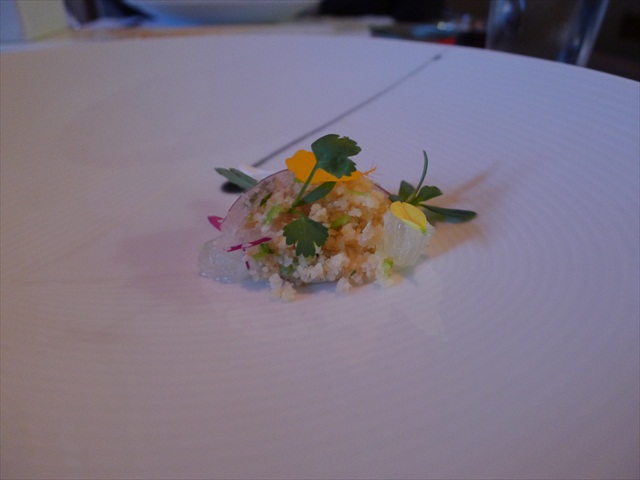 Next; chibé- an Amazonian style of cous cous, with carbonized herb oil, piquant vegetables and strident citrus. It’s refreshing and brisk- a wake up call for your palate. The texture is of soft sand, the taste of lemon pith and pickle.
Next; chibé- an Amazonian style of cous cous, with carbonized herb oil, piquant vegetables and strident citrus. It’s refreshing and brisk- a wake up call for your palate. The texture is of soft sand, the taste of lemon pith and pickle.
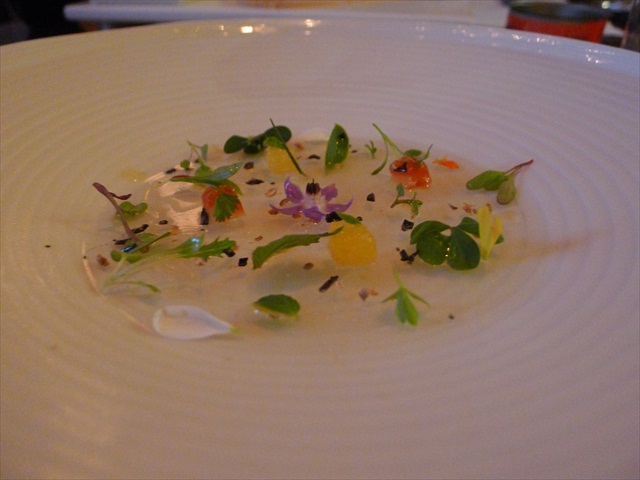 From there comes a firm contender for one of the prettiest dishes I’ve seen in a long time- it’s green tomato gel, like a plate of glass, pressed with flowers plucked from a meadow. There’s baby basil, borage flowers, fine dice of tomato and segments of citrus. The flavour of tomato chimes as clear as a bell.
From there comes a firm contender for one of the prettiest dishes I’ve seen in a long time- it’s green tomato gel, like a plate of glass, pressed with flowers plucked from a meadow. There’s baby basil, borage flowers, fine dice of tomato and segments of citrus. The flavour of tomato chimes as clear as a bell.
 Next; toasted black rice gussied up with vegetables and Brazil Nut milk. The black rice is a strain that has been cultivated and flourishes in the Sao Paulo climate. Conservation once again comes hand in hand with playfulness- while the knife skills are work in the garnishes are grand, to me the splayed vegetables most closely resemble a scene from ‘Ferngully‘. As for the taste; the rice contributes crunch and pop, like savoury rice bubbles, or the coveted soccarat crust on a paella.
Next; toasted black rice gussied up with vegetables and Brazil Nut milk. The black rice is a strain that has been cultivated and flourishes in the Sao Paulo climate. Conservation once again comes hand in hand with playfulness- while the knife skills are work in the garnishes are grand, to me the splayed vegetables most closely resemble a scene from ‘Ferngully‘. As for the taste; the rice contributes crunch and pop, like savoury rice bubbles, or the coveted soccarat crust on a paella.
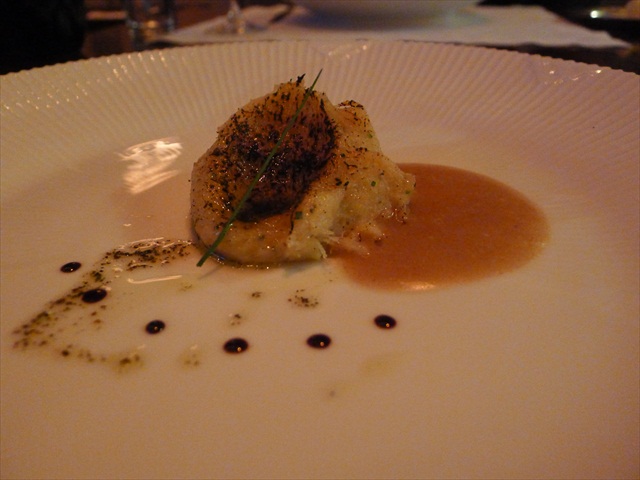 To follow, a dish that harks to the influence of the Portuguese colonisers, cod brandade, made rich with marrow. It’s a high wire suspension between fluffy and dense and impossibly rich, with spindles of salted fish peeking through whipped potato. The crown of it all is charred, like a marshmallow left to dance in front of a fire.
To follow, a dish that harks to the influence of the Portuguese colonisers, cod brandade, made rich with marrow. It’s a high wire suspension between fluffy and dense and impossibly rich, with spindles of salted fish peeking through whipped potato. The crown of it all is charred, like a marshmallow left to dance in front of a fire.
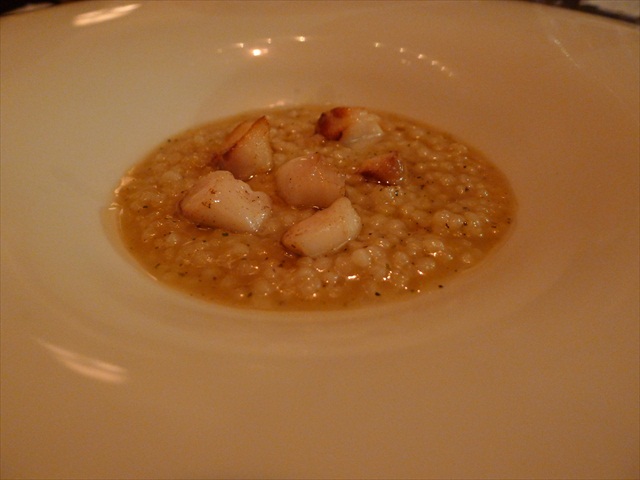 Next; more starch. One of Atala’s passion projects is developing and preserving original Brazilian products. The mini rice that follows is one such endeavour. Grown by small farmers it is one third of the size of normal rice, almost spherical and smooth. It’s presented with small nuggets of grouper slicked with vanilla oil. The rice itself is impossibly sticky. Eating it produces the same glossed lips that you’d get from devouring pork belly.
Next; more starch. One of Atala’s passion projects is developing and preserving original Brazilian products. The mini rice that follows is one such endeavour. Grown by small farmers it is one third of the size of normal rice, almost spherical and smooth. It’s presented with small nuggets of grouper slicked with vanilla oil. The rice itself is impossibly sticky. Eating it produces the same glossed lips that you’d get from devouring pork belly.
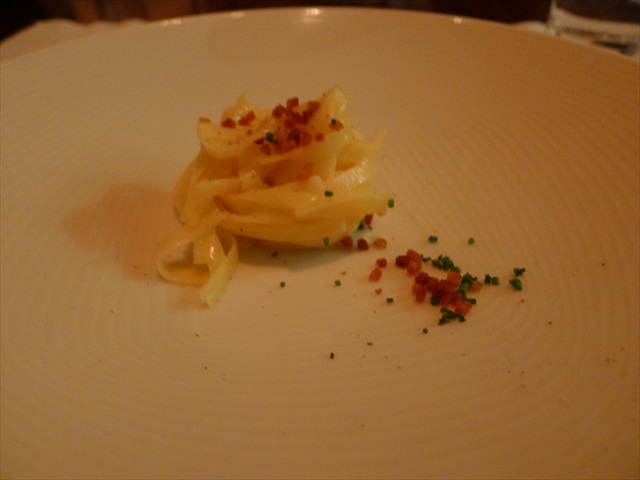 And then comes a nest of carbonara, with coiled strands of hearts of palm masquerading as al dente pasta. There are crumbles of ham and a sauce that’s thigh-gildingly rich. Lucky for all of us, the portion is relatively modest.
And then comes a nest of carbonara, with coiled strands of hearts of palm masquerading as al dente pasta. There are crumbles of ham and a sauce that’s thigh-gildingly rich. Lucky for all of us, the portion is relatively modest.
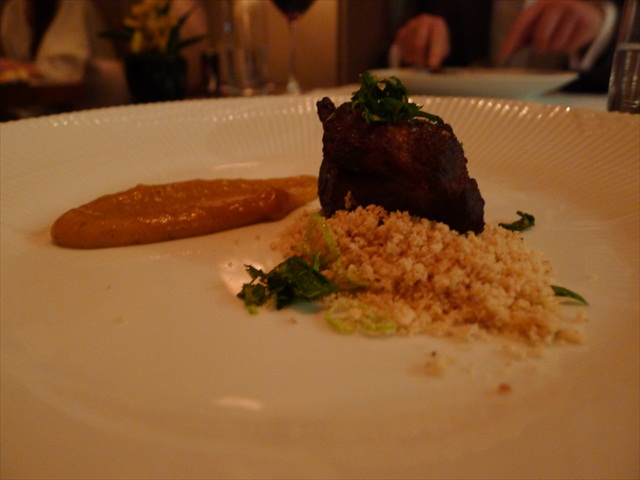 Main courses crescendo to a husky chunk of meat – a hunk of wild boar. The flavour sits somewhere in the flavour spectrum between beef and pork. Adding lightness are some twinkling flavours of caipirnhas, a dusting of lime zest and mint. Accompanying it are two flavours last seen in a churrasceria in Rio; toasted manioc flour and grilled banana.
Main courses crescendo to a husky chunk of meat – a hunk of wild boar. The flavour sits somewhere in the flavour spectrum between beef and pork. Adding lightness are some twinkling flavours of caipirnhas, a dusting of lime zest and mint. Accompanying it are two flavours last seen in a churrasceria in Rio; toasted manioc flour and grilled banana.
A slice or two of fried banana is a common Brazilian pairing with grilled meats – here Atala has turned the sweet charcoal flavours into a sticky puree. It’s a dish that may look French on the plate, but tastes of nothing but Brazil.
Just in case you’re not full to the brim, cheese course comes in the form of aligot.
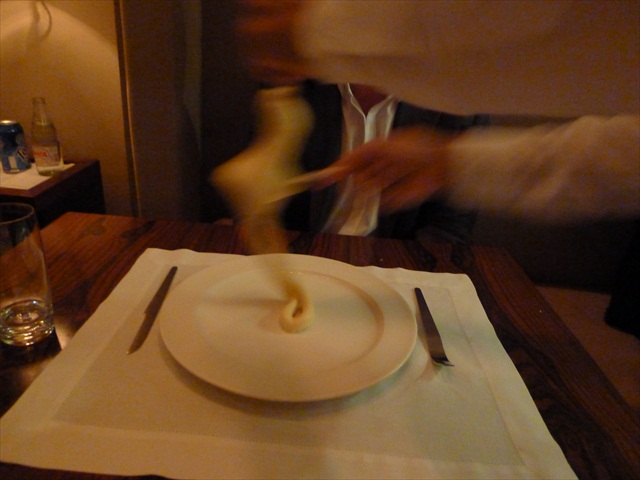 The first time I ate aligot was at Bras – it’s a dish traditional to the L’Aubrac region of France; an aspirational combination of potato and cheese, with Cantal traditionally whipped into the mashed root until the white mass can be stretched and suspended off spoons and forks, like drooping strands of melted mozzarella. Here it’s made with a combination of gruyere and fresh Brazilian Minas cheese. For a night in the middle of Sao Paulo summer, it’s heft upon heft.
The first time I ate aligot was at Bras – it’s a dish traditional to the L’Aubrac region of France; an aspirational combination of potato and cheese, with Cantal traditionally whipped into the mashed root until the white mass can be stretched and suspended off spoons and forks, like drooping strands of melted mozzarella. Here it’s made with a combination of gruyere and fresh Brazilian Minas cheese. For a night in the middle of Sao Paulo summer, it’s heft upon heft.
Desserts thankfully take a lighter path, from a lime gel ravioli with banana, creme patisserie and caramel fashioned from Amazonian roots. Lastly, it’s a sweet makeover for pumpkin, with cubes of gently cooked flesh candied, dusted with a dark powder (crafted from carbonized herbs). Draped with tapioca cream and cuddling next to coconut ice cream, it’s a sweet curiosity that keeps you going back and back to discover more with each bite.
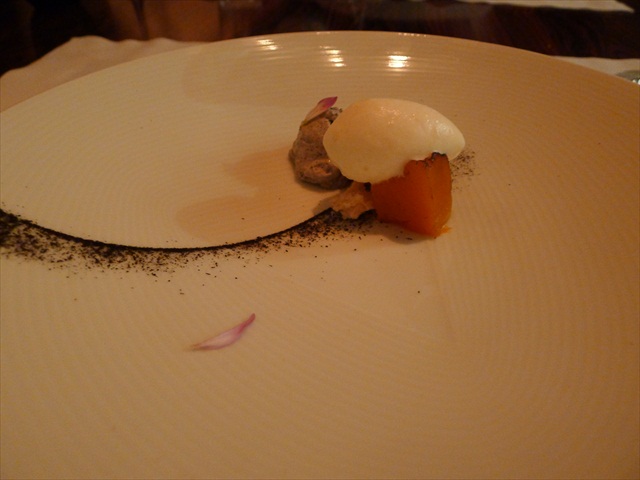 It all comes to a close with a platter of decidedly Parisian petit fours, macarons, truffles, gateau and then, for one final taste of Brazil, (and for me, the highlight); a small rendition of quindin, a local coconut flan, rich with egg and sticky with sugar.
It all comes to a close with a platter of decidedly Parisian petit fours, macarons, truffles, gateau and then, for one final taste of Brazil, (and for me, the highlight); a small rendition of quindin, a local coconut flan, rich with egg and sticky with sugar.
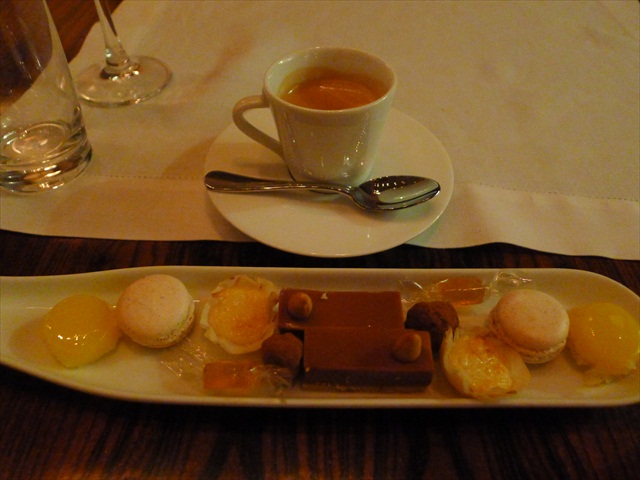 It’s a meal that takes you to places you never knew. It’s also a meal that sticks, in many ways. Despite the sparkling brightness of the tropical flavours at play, for midsummer, this is a tasting menu that’s burdensome with bulk. From the bread to potato to cous cous to rice, to cassava to aligot to pumpkin, there’s barely a course that doesn’t employ a carbohydrate as a base.
It’s a meal that takes you to places you never knew. It’s also a meal that sticks, in many ways. Despite the sparkling brightness of the tropical flavours at play, for midsummer, this is a tasting menu that’s burdensome with bulk. From the bread to potato to cous cous to rice, to cassava to aligot to pumpkin, there’s barely a course that doesn’t employ a carbohydrate as a base.
Our hotel is a mere seven blocks away. We wish it was further. For one, we’re hungry to explore more of this town that we’ve just begun to taste. And lastly, because the sheer bulk of the meal demands it. Here at D.O.M, God may be Optimum and Maximum, but at the end of dinner, so is our girth.
D.O.M
Rua Barão de Capanema, 549, Jardins São Paulo, 01411-011, Brazil
http://www.domrestaurante.com.br/
Hints and tips:
We stayed at the George V Casa Branca, which was a lovely hotel just a ten minute walk away from D.O.M (nb, this is a safe, upmarket area of Sao Paulo. We had no qualms about walking about at night.
http://www.georgev.com.br
We used Sao Paulo Airport Transfers, who were also terrific.
http://www.saopauloairporttransfers.com/

